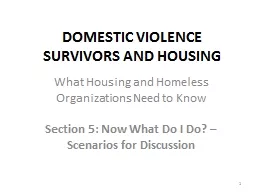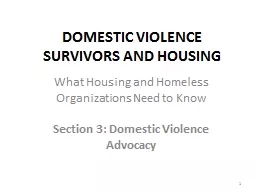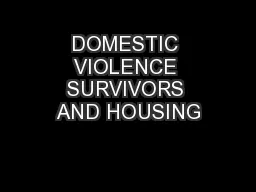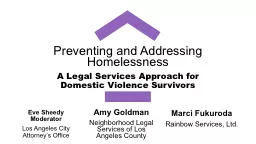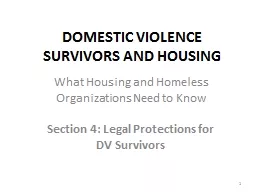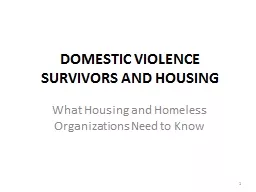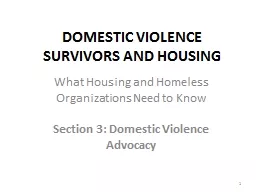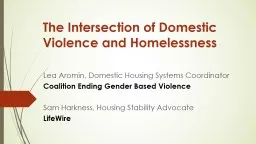PPT-DOMESTIC VIOLENCE SURVIVORS AND HOUSING
Author : tatyana-admore | Published Date : 2019-11-27
DOMESTIC VIOLENCE SURVIVORS AND HOUSING Section 5 Now What Do I Do Scenarios for Discussion 1 What Housing and Homeless Organizations Need to Know Theres current
Presentation Embed Code
Download Presentation
Download Presentation The PPT/PDF document "DOMESTIC VIOLENCE SURVIVORS AND HOUSING" is the property of its rightful owner. Permission is granted to download and print the materials on this website for personal, non-commercial use only, and to display it on your personal computer provided you do not modify the materials and that you retain all copyright notices contained in the materials. By downloading content from our website, you accept the terms of this agreement.
DOMESTIC VIOLENCE SURVIVORS AND HOUSING: Transcript
DOMESTIC VIOLENCE SURVIVORS AND HOUSING Section 5 Now What Do I Do Scenarios for Discussion 1 What Housing and Homeless Organizations Need to Know Theres current DV We dont have the resourcesour location isnt confidential. Section 2: Recognizing and Responding to Domestic Violence. 1. What Housing and Homeless Organizations Need to Know. Identification and Screening. Some survivors self-identify or are referred by DV agency. . Between. Domestic Violence and Homelessness. Presented By. Abeer Monem, Director of Programs. Fort Bend County Women’s Center. Barbie Brashear, Executive Director. Harris County Domestic Violence Coordinating Council. Section . 3: Domestic Violence Advocacy. 1. What Housing and Homeless Organizations Need to Know. Domestic Violence Advocacy. Trauma Informed, Survivor Driven. Strength Based . Emotional & Physical Safety Oriented. What Housing and Homeless Organizations Need to Know. 1. OUTLINE. Domestic Violence and Homelessness (4-7). Recognizing and Responding to DV (8-15). Domestic Violence Advocacy (16-33). Confidentiality (17). Preventing and Addressing Homelessness. A Legal Services Approach for Domestic Violence Survivors. Marci . Fukuroda. Rainbow Services, Ltd.. Amy Goldman. Neighborhood Legal Services of Los Angeles County. Section . 4: Legal Protections for DV Survivors . 1. What Housing and Homeless Organizations Need to Know. Violence Against Women Act 2005. Housing Strategies. .. Housing and Urban Development (HUD) Agency reporting requirements imposed on public housing applicants must include any plans to address domestic violence, dating violence, sexual assault and stalking in their application. . Preventing and Addressing Homelessness. A Legal Services Approach for Domestic Violence Survivors. Marci . Fukuroda. Rainbow Services, Ltd.. Amy Goldman. Neighborhood Legal Services of Los Angeles County. DV and Homelessness Domestic Violence for Housing/Homeless Providers The Relationship IS the Intervention! OUTLINE DV and Homelessness Recognizing and Responding to Domestic Violence Safety Planning: Safety versus DOMESTIC VIOLENCE SURVIVORS AND HOUSING What Housing and Homeless Organizations Need to Know 1 OUTLINE Domestic Violence and Homelessness (4-7) Recognizing and Responding to DV (8-15) Domestic Violence Advocacy (16-33) Legal protections for Dv survivors Violence Against Women Act (2013) Under VAWA, survivors have the right to: Be accepted into shelter/housing . For example, a housing provider cannot deny an applicant housing/assistance because of domestic violence, including a criminal history or poor credit history connected with domestic violence; Section . 3: Domestic Violence Advocacy. 1. What Housing and Homeless Organizations Need to Know. Domestic Violence Advocacy. Trauma Informed, Survivor Driven. Strength Based . Emotional & Physical Safety Oriented. TRAINING JANUARY 29 , 2016 1 Rental Housing Rights of Domestic Violence Survivors Overview Fair housing laws and domestic violence California protections for survivors VAWA 2013 overview NO ONE DESERVES TO BE ABUSED THERE ARE OPTIONSWe thank you for your support Your contributions allow us to giftsofhopeunlimitedorgSupporting and assisting individuals gain access to resources for OUR Violence . and Homelessness. Lea Aromin, Domestic Housing Systems Coordinator. Coalition Ending Gender Based Violence . Sam Harkness, Housing Stability Advocate. LifeWire. . Key Takeaways. The Intersection of DV and Homelessness: you are working with survivors every day!.
Download Document
Here is the link to download the presentation.
"DOMESTIC VIOLENCE SURVIVORS AND HOUSING"The content belongs to its owner. You may download and print it for personal use, without modification, and keep all copyright notices. By downloading, you agree to these terms.
Related Documents

